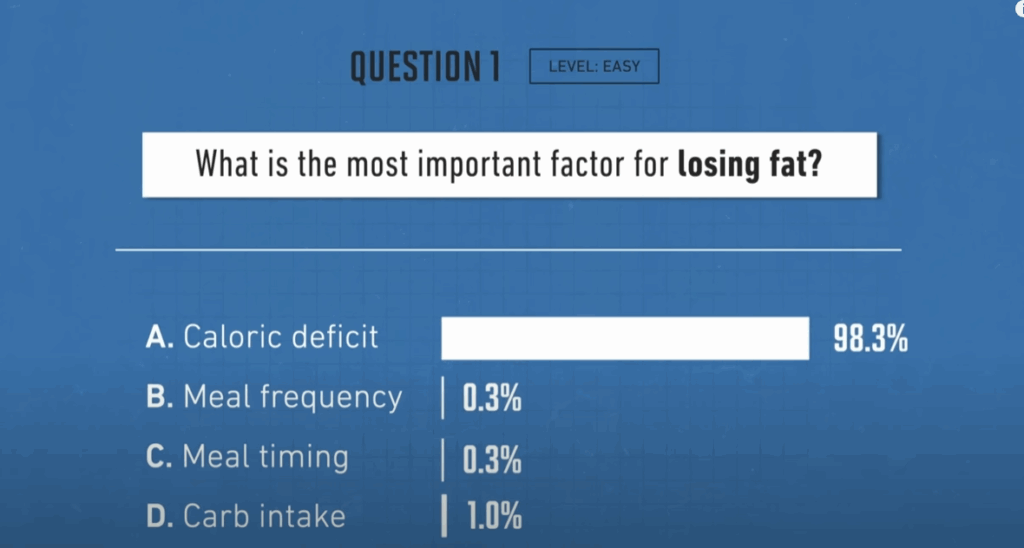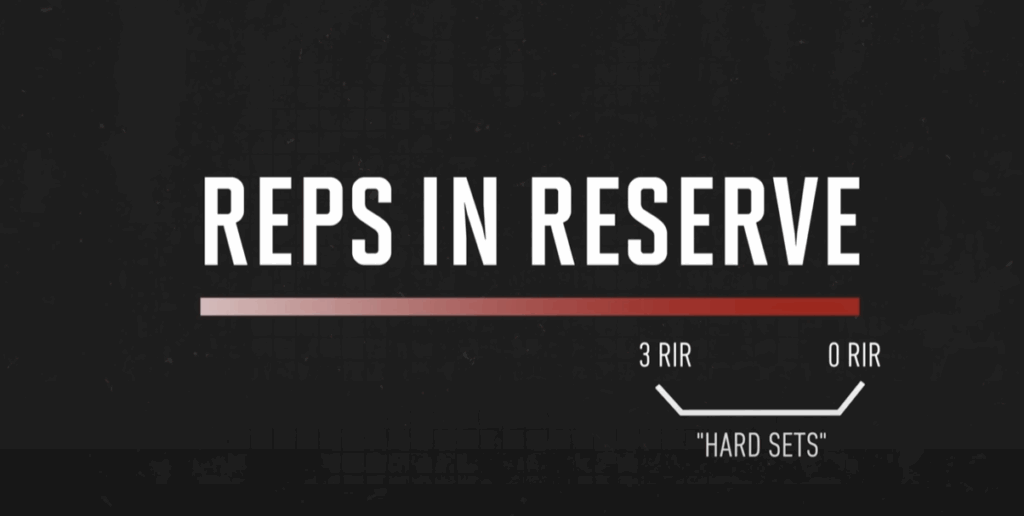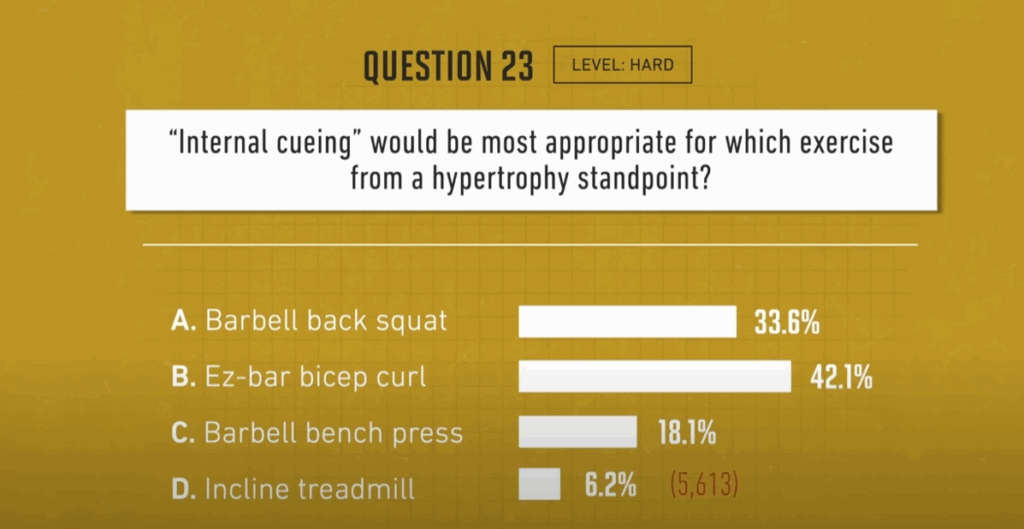How Smart Is the Fitness Community? Surprising Takeaways from a 113,000-Person Muscle IQ Test
What do over 100,000 lifters really know about muscle growth, fat loss, and strength training? Recently, an online quiz tested the fitness knowledge of more than 113,000 individuals, covering topics like training science, hypertrophy, and dieting strategies. With 30 carefully structured multiple-choice questions, the results offered a fascinating glimpse into the general understanding of evidence-based fitness.
From common myths to misunderstood muscles, here’s what the data revealed—plus the science-backed answers that every serious lifter should know.

Fat Loss Fundamentals: Most Get the Basics Right
Nearly everyone got the first question correct: 98% correctly identified a calorie deficit as the most critical requirement for fat loss. No matter how “clean” or “dirty” the diet, unless your energy intake is lower than your energy expenditure, the scale won’t budge in the direction you want. Macronutrient timing, carb manipulation, or fasting may help adherence—but thermodynamics rule the game.
Muscle Building: Do You Have to Train to Failure?
A high percentage—90%—recognized that failure training isn’t required to grow muscle. While pushing close to failure increases intensity and can boost hypertrophy, effective training still happens several reps shy of the limit. Using failure as a strategic tool rather than a mandatory principle is a more sustainable and often more effective method, especially for compound lifts where fatigue can impair form.
Can You Build Muscle and Burn Fat at the Same Time?
One of the most debated topics in fitness: recomposition. A strong 96% answered correctly that yes, you can simultaneously build muscle and lose fat, especially if you’re new to training, coming back after a break, or significantly overweight. However, advanced lifters may need to separate bulking and cutting phases to continue progressing.
Who Struggles Most with Recomposition?
Advanced lean trainees were identified by 86% of respondents as the group that finds it hardest to achieve recomposition. Once you’re near your genetic ceiling, gaining additional muscle often requires a surplus of calories, making simultaneous fat loss far less efficient.

Supplements: What Works and What Doesn’t?
When asked about the most well-supported supplement for muscle and strength, 87% answered creatine monohydrate. That’s correct. Despite the popularity of branched-chain amino acids (BCAAs), they don’t offer additional benefits beyond adequate protein intake. Creatine, on the other hand, remains king, backed by decades of consistent evidence.
Efficient Rep Ranges for Growth
The optimal rep range for hypertrophy? According to 92% of quiz takers, it’s 6–15 reps per set—spot on. This range allows for adequate mechanical tension and volume without overly taxing the nervous system or risking poor recovery. Lower reps require more sets to accumulate volume, and ultra-high reps can lead to excessive fatigue with diminishing returns.
Anatomy Misconceptions: Muscles Missed on Rows
Only 49% of participants correctly picked the anterior deltoid as the least involved muscle in a cable row. It’s true—front delts primarily work during pressing motions, not pulling. On the other hand, lats, traps, and biceps are all heavily recruited during rows due to their role in elbow flexion and scapular retraction.
Understanding the Eccentric Phase
When it comes to muscle damage and growth, the eccentric (lowering) phase of a lift matters. 77% of users correctly answered that this is when the biceps lengthen under load in a curl, and controlling this phase leads to better hypertrophy results.
The Main Driver of Muscle Growth
Which factor contributes most to hypertrophy? The majority were split, but mechanical tension is the correct answer. While muscle damage and metabolic stress do play roles, progressive overload through mechanical tension remains the cornerstone of muscle adaptation.
RP and RIR: Tools for Smarter Programming
Most respondents understood that RPE (Rating of Perceived Exertion) and RIR (Reps in Reserve) are subjective tools used to gauge training intensity. Knowing when you’re one or two reps from failure can help manage fatigue and tailor effort more effectively over time.
Longer Rest Periods = Better Gains?
One surprising insight: when asked about rest periods, responses were split. Yet, the science supports longer rest intervals (60+ seconds) for hypertrophy, allowing you to maintain higher output per set, which contributes to greater volume and better results.
Progressive Overload: What Doesn’t Count?
While increasing reps, sets, or weight are all forms of progressive overload, 88% correctly identified that constantly changing exercises isn’t a reliable method. Variety has its place, but it should complement—not replace—core movements tracked for progress.
Muscle Soreness: Meaningful or Misleading?
Soreness can help signal whether you’re targeting the right muscle, but it doesn’t directly equate to growth. Running a marathon will leave you sore, but that doesn’t mean you’re building mass. It’s a feedback tool, not a progress metric.
Frequency for Glute Training
When asked about optimal frequency for glute development, most lifters agreed on two to three sessions per week. This range allows sufficient volume and recovery, maximizing stimulus without risking overtraining.

Internal vs. External Cues in Lifting
Internal focus—thinking about squeezing a muscle—can help with isolation exercises like curls, but external cues (e.g., “drive through your feet”) tend to work better for compound lifts. Research shows internal focus can actually reduce strength output during heavy squats or presses.
Understanding Hamstring Activation in Squats
Only 75% recognized that hamstrings are minimally activated during a standard barbell back squat. That’s because they act across both the hip and knee joints, limiting effective stretch and tension. For serious hamstring development, exercises like Romanian deadlifts or leg curls are better choices.
Recommended Protein Intake in a Surplus
A caloric surplus changes protein needs slightly. Still, most lifters benefit from 1.6–2.2 grams of protein per kilogram of body weight. Going higher might be beneficial when dieting, but in a surplus, the upper range is generally sufficient.
What Hurts Muscle Growth?
Believe it or not, cold water immersion can reduce muscle protein synthesis and blunt hypertrophy. While ice baths may aid recovery from soreness, they can hinder long-term muscle growth if used regularly post-training.
Final Thoughts: Fitness IQ Is Solid—But There’s Room to Grow
Across all 30 questions, the average score was 61%—a respectable result for a fairly difficult test. Only a tiny fraction—roughly 1 in 1,000—scored a perfect 30/30. While most people nailed the fundamentals, advanced topics like fiber types, periodization models, and refeed strategies tripped many up.
The takeaway? Most lifters have a decent grasp of the basics, but there’s still a big opportunity to deepen your understanding—especially if you’re serious about long-term results.
Want to challenge your own muscle IQ? The test is still available online for anyone ready to put their knowledge to the test.



